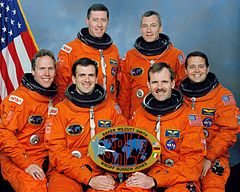STS-68
| STS-68 | |
|---|---|
 | |
| Údaje o expedici | |
| Loď | Endeavour |
| COSPAR | 1994-062A |
| Členů expedice | 6 |
| Trvání | 11 dní, 5 hodin, 46 minut, 8 sekund |
| Datum startu | 30. září 1994 07:16:01 EDT |
| Kosmodrom | Kennedyho vesmírné středisko, Florida (USA) |
| Vzletová rampa | LC-39A |
| Datum přistání | 11. října 1994 01:02:09 EDT |
| Místo přistání | Edwardsova letecká základna |
| Fotografie posádky | |
 | |
| Zleva stojí Baker a Wilcutt, sedí Jones, Wisoff, Smith a Bursch | |
| Navigace | |
Předchozí STS-64 Následující STS-66 | |
STS-68 byla mise raketoplánu Endeavour. Celkem se jednalo o 65. misi raketoplánu do vesmíru a 7. pro Endeavour. Cílem letu mise byly experimenty Space Radar Laboratory.
Posádka
 Michael A. Baker (3) velitel
Michael A. Baker (3) velitel Terrence W. Wilcutt (1) pilot
Terrence W. Wilcutt (1) pilot Thomas D. Jones (2) velitel užitečného zatížení
Thomas D. Jones (2) velitel užitečného zatížení Steven L. Smith (1) letový specialista 2
Steven L. Smith (1) letový specialista 2 Daniel W. Bursch (2) letový specialista 3
Daniel W. Bursch (2) letový specialista 3 Peter J. K. Wisoff (2) letový specialista 4
Peter J. K. Wisoff (2) letový specialista 4
V závorkách je uvedený dosavadní počet letů do vesmíru včetně této mise.
Reference
V tomto článku byl použit překlad textu z článku STS-68 na anglické Wikipedii.
Externí odkazy
 Obrázky, zvuky či videa k tématu STS-68 na Wikimedia Commons
Obrázky, zvuky či videa k tématu STS-68 na Wikimedia Commons - (anglicky) Stránka o letu na stránkách NASA Archivováno 4. 1. 2013 na Wayback Machine.
Média použitá na této stránce
The crew of the Space Shuttle mission STS-68 described by NASA as follows. :Standing are, left to right, Michael A. Baker, mission commander; and Terrence W. Wilcutt, pilot. On the front row are, left to right, Thomas D. Jones, payload commander; and Peter J. K. (Jeff) Wisoff, Steven L. Smith and Daniel W. Bursch, all mission specialists.
STS-68 Mission Insignia


